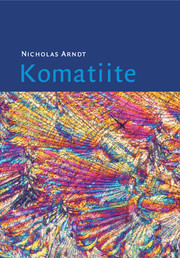Book contents
- Frontmatter
- Contents
- Preface
- Part I Background information – description of the field characteristics, mineralogy and geochemistry of komatiites
- 1 A brief history of komatiite studies and a discussion of komatiite nomenclature
- 2 Brief descriptions of six classic komatiite occurrences
- 3 Field characteristics, textures and structures
- 4 Mineralogy
- 5 Geochemistry
- 6 Isotopic compositions of komatiites
- 7 Experimental petrology
- Part II Interpretation – the manner of emplacement, the origin and the tectonic setting of komatiites
- References
- General index
- Localities
- Plate section
1 - A brief history of komatiite studies and a discussion of komatiite nomenclature
from Part I - Background information – description of the field characteristics, mineralogy and geochemistry of komatiites
Published online by Cambridge University Press: 27 August 2009
- Frontmatter
- Contents
- Preface
- Part I Background information – description of the field characteristics, mineralogy and geochemistry of komatiites
- 1 A brief history of komatiite studies and a discussion of komatiite nomenclature
- 2 Brief descriptions of six classic komatiite occurrences
- 3 Field characteristics, textures and structures
- 4 Mineralogy
- 5 Geochemistry
- 6 Isotopic compositions of komatiites
- 7 Experimental petrology
- Part II Interpretation – the manner of emplacement, the origin and the tectonic setting of komatiites
- References
- General index
- Localities
- Plate section
Summary
The discovery and early investigations of komatiite
A review of reports written by field geologists in the early twentieth century reveals many references to ultramafic volcanic rocks. These rocks were identified as extrusive because of their volcanic textures and structures, and they seem to have been accepted as a normal component of Archean volcanic successions. Then, between 1920 and 1930, as Bowen and other petrologists conducted the experimental studies that led them to question the very existence of ultramafic magma (Bowen, 1928), and as the influence of these petrologists spread, descriptions of ultramafic volcanics virtually disappeared from the geological literature. There were sporadic reports of serpentinite flows in younger terranes, as reviewed by Bailey and McCallien (1953), and argument persisted about the nature and origin of ‘alpine peridotites’, but references to ultramafic lavas in Archean areas became rare. In a few Canadian papers, the texture we now know as spinifex was described, and the rocks containing these textures were interpreted as volcanic (Berry, 1940; Prest, 1950; Abraham, 1953). Similar reports appeared of ultramafic lavas in various parts of the (then) Rhodesian craton (Keep, 1929; Wiles, 1957). More commonly, however, the ultramafic rocks were interpreted as intrusive, in most cases as the lower cumulate layers of differentiated sills. This is the case for two type areas of komatiite, Barberton in South Africa and Munro Township in Canada.
- Type
- Chapter
- Information
- Komatiite , pp. 3 - 15Publisher: Cambridge University PressPrint publication year: 2008

